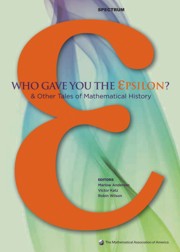Book contents
- Frontmatter
- Introduction
- Contents
- Analysis
- Foreword
- Who Gave You the Epsilon? Cauchy and the Origins of Rigorous Calculus
- Evolution of the Function Concept: A Brief Survey
- S. Kovalevsky: A Mathematical Lesson
- Highlights in the History of Spectral Theory
- Alan Turing and the Central Limit Theorem
- Why did George Green Write his Essay of 1828 on Electricity and Magnetism?
- Connectivity and Smoke-Rings: Green's Second Identity in its First Fifty Years
- The History of Stokes' Theorem
- The Mathematical Collaboration of M. L. Cartwright and J. E. Littlewood
- Dr. David Harold Blackwell, African American Pioneer
- Afterword
- Geometry, Topology and Foundations
- Algebra and Number Theory
- Surveys
- Index
- About the Editors
Why did George Green Write his Essay of 1828 on Electricity and Magnetism?
from Analysis
- Frontmatter
- Introduction
- Contents
- Analysis
- Foreword
- Who Gave You the Epsilon? Cauchy and the Origins of Rigorous Calculus
- Evolution of the Function Concept: A Brief Survey
- S. Kovalevsky: A Mathematical Lesson
- Highlights in the History of Spectral Theory
- Alan Turing and the Central Limit Theorem
- Why did George Green Write his Essay of 1828 on Electricity and Magnetism?
- Connectivity and Smoke-Rings: Green's Second Identity in its First Fifty Years
- The History of Stokes' Theorem
- The Mathematical Collaboration of M. L. Cartwright and J. E. Littlewood
- Dr. David Harold Blackwell, African American Pioneer
- Afterword
- Geometry, Topology and Foundations
- Algebra and Number Theory
- Surveys
- Index
- About the Editors
Summary
1 Honor to Green
Among the centenaries of mathematicians and scientists celebrated in 1993, perhaps the most remarkable was the bicentenary of the birth of a professional miller and part-time mathematician, one George Green (1793–1841) of Sneinton, then near Nottingham. Among other achievements, he was the creator of theorems and functions now named after him which make him a principal contributor to potential theory and to its applications in mechanics and mathematical physics.
During the week corresponding to that of his birth (which occurred on 14 July) various events took place. A three-day conference was held at the University of Nottingham, mainly on the use of his work in modern mathematics and physics. It included a visit to the mill at Sneinton which had been restored and opened as a science center in 1985. The next day a stained glass window was dedicated at the Gonville and Caius College, Cambridge, where he was resident from 1833 to 1837 as an extremely mature student, and (only) for the winter of 1839–1840 as a Fellow. Finally, on Friday 16 July a meeting was held at the Royal Society of London on his life and work and the modern importance of the latter. It was followed by a quite exceptional event: the unveiling of a plaque in his memory in the floor of the nave of Westminster Abbey, close to the tomb of Isaac Newton and to the plaques for his first publicist Lord Kelvin, Michael Faraday and Clerk Maxwell.
- Type
- Chapter
- Information
- Who Gave You the Epsilon?And Other Tales of Mathematical History, pp. 61 - 68Publisher: Mathematical Association of AmericaPrint publication year: 2009

